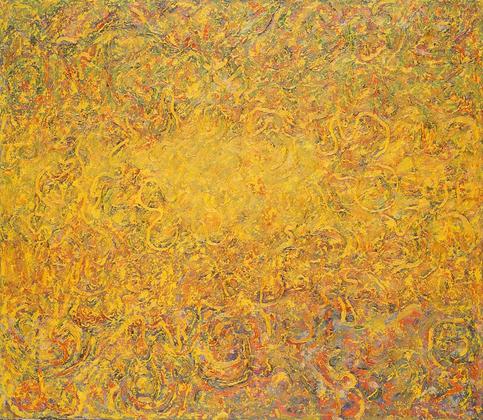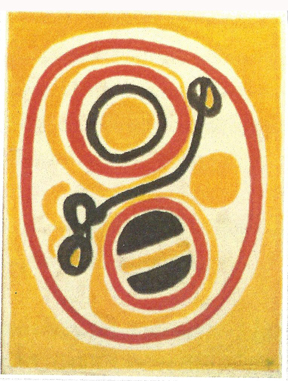
This work of Beauford Delaney – The PicNic, 1940 – is part of the exhibition ’In Profile. Portraits from the Permanent Collection’, Studio Museum Harlem. March 26 until June 28, 2015.
About:
1901-1979 Beauford Delaney struggled with poverty, mental illness, and obscurity throughout his career as a painter. Since his death, museum retrospectives have reestablished Delaney as one of America’s most vital expressionist painters.
A Promising Young Artist
Delaney was born in Knoxville, Tennessee, on December 30, 1901. His father, Samuel, was a Methodist minister. His mother, Delia, was a freed slave who never learned to read or write. While she worked as a domestic servant in the households of prominent white families, she taught her children not to be ashamed of their black ancestry and pushed them to become educated. Delaney was the eighth of 10 children, many of whom died in infancy. Throughout his life, he maintained a strong and often fiery relationship with his younger brother, Joseph, who also became an artist.
 James Baldwin, 1965.
James Baldwin, 1965.
The two brothers demonstrated impressive artistic abilities from a young age. Together, they spent many hours making clay figures and copying pictures from their father’s Bible. While still a teenager, Delaney got a job painting signs at the Post Sign Company in Knoxville. His work quickly came to the attention of Lloyd Branson, a prominent local artist. Branson, a white man in his late 60s, had achieved some fame as a commercial artist and supported himself in his retirement painting portraits. He took Delaney on as his porter in exchange for painting and portraiture lessons.
 1944.
1944.
In 1924, with the help of Branson, Delaney left the south to continue his art education in Boston. Although he never enrolled as a full-time student, Delaney studied throughout the 1920s at the Massachusetts Normal School and the South Boston School of Art. His charm and easy wit ingratiated him with a circle of prominent African American activists in the city. Among Delaney’s acquaintances during this period were writer James Weldon Johnson, and William Monroe Trotter, founder of the National Equal Rights League.
 Exchange Place, 1943.
Exchange Place, 1943.
By the end of the 1920s, Delaney resolved that to fulfill his artistic aspirations, he needed to move to New York City. When he arrived in 1929, the Harlem Renaissance was in full swing. Delaney soon became a recognized painter, notorious for his unorthodox portraits of prominent black artists such as Duke Ellington and Louis Armstrong. Several of these portraits were exhibited at the Whitney Museum in 1930.
Life in New York and Paris:
In the 1930s, Delaney was influenced by the saturated colors and distorted spaces found in the paintings of the French master Henri Matisse. Each color took on a symbolic meaning in Delaney’s paintings and he used specific combinations of colors to imbue his subjects with particular narratives. For example, the 1938 painting titled Washington Square employed bold yellow areas, complimented by blue and lavender shadows and thick black outlines. The dominant yellow is intended to infuse this familiar New York scene with a sense of regeneration and redemption.
 Composition 16, 1965.
Composition 16, 1965.
Delaney took up residence in the Greenwich Village area of New York. When income was lean, he fell back on portraiture commissions and traded work as a maintenance man and doorman for studio space. New York was a more socially permissive environment than Delaney had previously encountered, and for the first time, he openly experimented with his sexuality. When his younger brother joined him in the city a year after his own arrival, Joseph was shocked and upset by this seemingly radical change in his brother. The two remained close, but a rift formed in their relationship due to Joseph’s intolerance of his brother’s lifestyle.
 Untitled, 1958.
Untitled, 1958.
In New York, Delaney also forged the most important friendship of his life when he met James Baldwin. Baldwin would go on to become an important novelist and essayist, but still a teenager at the time of their meeting, he looked to Delaney as a role model. Delaney was the first African American artist that Baldwin met, and his dedication to his painting, despite financial hardships, proved to the young writer that it was possible to make a life as an artist. For Delaney, the friendship gave him the opportunity to play the role of mentor.
In 1938, Delaney gained national notoriety when Life magazine featured photographs of him painting in Washington Square. However, his success never translated into financial security The 1940s found Delaney living in an apartment with no electricity and a leaking roof. In the winter, the water that came through the ceiling formed a sheet of ice on the floor, and Delaney showed curators and collectors his new work by candlelight. To escape the hardships of New York, Delaney followed Baldwin to Paris in 1953. Although he traveled back to the United States several times, Paris remained his home until his death. This relocation to Europe facilitated a radical stylistic shift for the painter. Leaving New York, Delaney also left behind his attachment to representational and figurative art. In Paris, he began to experiment with purely abstract compositions, and developed a form of abstract expressionism several years before New York painters such as Jackson Pollack and Mark Rothko began to pursue similar ideas.
Despite the new energy in his artwork, the 25 years that Delaney spent in Paris were not happy ones. He had suffered since childhood from paranoia and often complained of hearing voices. In Europe, these problems were exacerbated by heavy drinking and isolation. In the 1960s and 1970s, Delaney’s mental health deteriorated and he was periodically hospitalized. Although Baldwin continued to care for his friend and provide for him financially, Delaney was finally institutionalized at St. Anne’s Hospital for the Insane in 1975. He died there on March 26, 1979.
 Yellow, red and black circles, 1966.
Yellow, red and black circles, 1966.
Following his death, Baldwin and Joseph Delaney worked together to protect and promote Delaney’s work. Despite their attempts to secure his reputation as an influential American painter, it was not until the 1990s that there was a resurgence of interest in Delaney’s work. Since that time, his paintings have been exhibited at many major institutions in America, including the Fogg Art Museum at Harvard University and Atlanta’s High Museum.
(from BlackHistoryNewSite)
